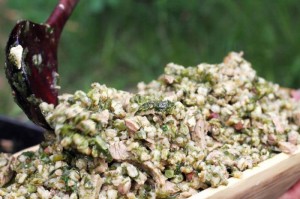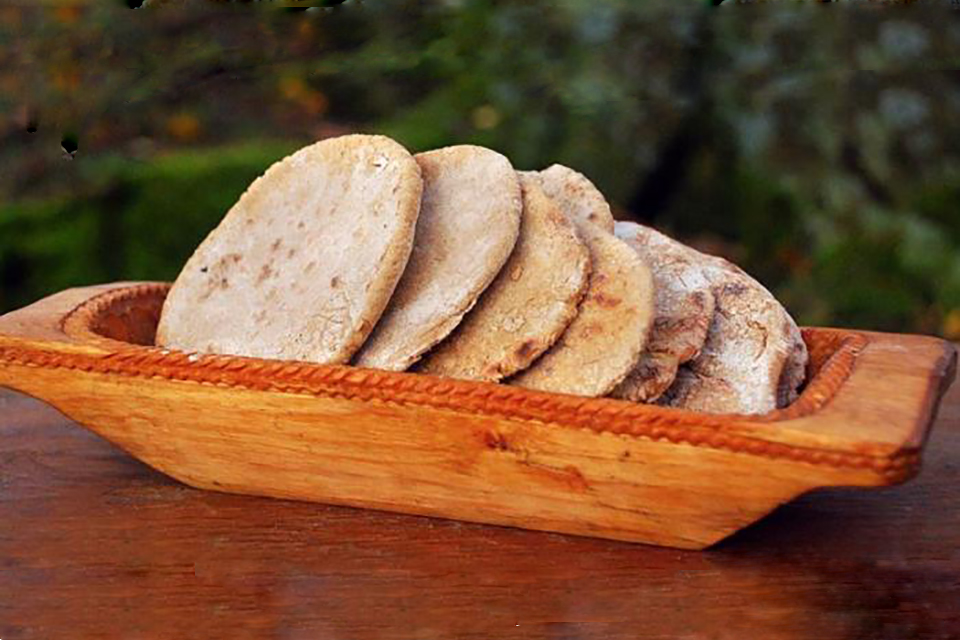BOOK REVIEW: An Early Meal is a Viking Age Cookbook and a culinary Odyssey worth placing near your hearth in your kitchen…
This is simply a great book. On one hand it presents us with a careful and detailed introduction to the archaeological evidence of what the Vikings really did eat. Complete with several appendixes – lists of plant remains found at archaeological sites, an encyclopeadia listing foodstuff, an overview of cooking techniques and implements plus a comprehensive list of references. This is obviously not a “quick and dirty book”, primarily meant to excite the typical shopper at medieval markets or in the museum bookshops catering for the culturally uneducated masses.
On the other hand it ALSO presents us with a rich collection of inspiring recipes obviously meant to seduce us all to take up Viking cooking. Not least, because the foodstuff and the cooked dishes are so beautifully photographed.
Thus the authors have apparently sought carefully to balance between producing an appetising and inspiring cook-book as well as a thoroughly documented introduction to the eating habits of the Vikings. In this they have succeeded to a large extent.
However, slight shortcomings can be found. Although not really marring the achievement, one might have wished for a little more care. To give an example, we are presented with a very interesting recipe for a black bread, found in a grave in Sweden. The burial was a cremation pyre, close to which a kind of bread-like biscuit was found. An analysis showed that it contained mainly wheat, but also seeds of white goosefoot. The latter might have been mixed up in the bread by accident, write the authors. However, it may also have been included deliberately. Further it had an unusually high content of protein (but no fat) plus a trace of saccaromyceteae, brewer’s yeast. All pointing to it being a bread baked of a mixture of wheat and blood – basically a kind of bread akin to the mixture in blood-sausages or black puddings, a typical Scandinavian specialty with medieval roots (found also in England, Germany, Spain (Morcilla) and elsewhere in Europe.)

© An Early Meal
The point here is not so much the recipe of the bread or its inclusion in the book. However, we are told in the title it came from Birka (Black bread in Birka, p. 154). However, in the text accompanying the recipe, we are told (correctly?) that it was found in a grave in South Sörmland, which although close to Birka, is a different place. However, we are not exactly told where the burial was from, and we might suspect that it was in fact from a place called Västbyn, in Fröson in the province of Jämtland. (As analysed by Hakon Helmquist from Lund, who published his findings in 1990 [1] ). Such bread was called ‘paltbröd’ and is still marketed in Sweden today and served
In another imprecise introduction to another recipe presented for small round, flat breads form Birka (and this time it is a correct geographical designation) the authors claim that the breads were probably remnants of everyday day life, although they also mention they were found in the cremated graves in Birka and obvious grave-goods. However, they forget to mention the curious fact that 42% of these breads were found in graves with rich gifts, which otherwise only represented 20% of all graves excavated at Birka [2]. These breads were furthermore threaded on iron-string rings. Why would the people in Birka use a valuable metal instead of a common string of flax or hemp to hang the bread, if not to honour the dead in an extraordinary way? Furthermore, loaves were often placed within the grave urn or just beside it, the most important location in the grave. Finally it is worth mentioning that bread deposits often coincided in the Birka graves with Thor´s hammer rings also made of iron, sometimes as metal pendants. Curious is it also that these breads more often than not were made of barley or wheat. More general surveys of the types of grain cultivated here, shows that for instance rye must have played an important role in the daily life.
Perhaps the small round breads from Birka were after all not that common…
But what about the recipe? Is it worthwhile to try it out? The answer is definitely yes! Here goes:
Bread from Birka
Take ½ dl dried peas and soak them in one dcl cold water and leave them overnight. Drain off the water, add another dcl and boil until soft. Then drain the water into a separate bowl, crush the peas and mix both again (or use an electric whisker on the pea-gruel!). Cool it and mix with 6dcl coarse barley flour, 2 ½ dcl water and (optional) salt. Divide the dough into 8 balls, flatten or roll these to a thickness about 1/1 to one cm and fry them in a frying pan – with no fat, the recipe says. (It is probable they were originally baked on a flat stone, initially heated in a fire, afterwards cleaned of the debris and then used for baking). The bread should be eaten fresh or alternatively served with or in a soup).
The two authors of the book have a long background in culinary history. Daniel Serra is working on a doctoral thesis on Viking Age food culture and is an experimental culinary archaeologist. Hanna Tunberg has a background as food connoisseur, taste expert and archaeologist. They have previously written a medieval cookbook “En sås av ringa värde”
An Early Meal – A Viking Age Cookbook & Culinary Odyssey
By Daniel Serra and Hanna Tunberg
ChronoCopia Publishing; 1st edition (2013)
ISBN-10: 9198105604
ISBN-13: 978-9198105605’
FEATURED PHOTO:
Viking Bred © An Early Meal
READ MORE ABOUT EARLY VIKING BREAD
[1] Über die Zusammensetzung einiger prähistorischer Brote.
By H. Hjelmqvist
In: Fornvännen 85, pp. 9-21.
[2] Pre – and protohistoric bread in Sweden : a definition and a review
By Ann-Marie Hansson
In: Pain, fours et foyers des temps passes. Vol 49, 2002 of Civlisation. Revue international d’antrhopologie et de sciences humaines.
